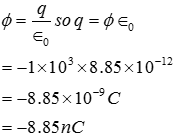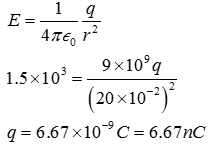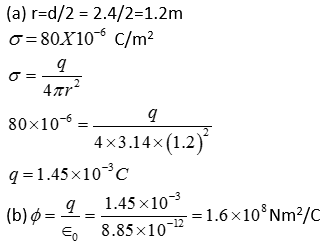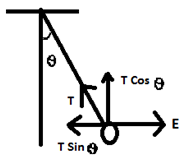Electric Charges and Fields - Online Test
Q1. Careful measurement of the electric field at the surface of a black box indicates that the net outward flux through the surface of the box is . (a) What is the net charge inside the box? (b) If the net outward flux through the surface of the box were zero, could you conclude that there were no charges inside the box?
Answer : Option C
Explaination / Solution:
(a) Net outward flux through the surface of the box, ϕ = 8.0 × N /C For a body containing net charge q, flux is given by the relation, = Permittivity of free space = 8.854 × N^{−1} We have q = ϕ = 8.854 × × 8.0 × = 7.08 × = 0.07 μC Therefore, the net charge inside the box is 0.07 μC. (b) No Net flux piercing out through a body depends on the net charge contained in the body. If net flux is zero, then it can be inferred that net charge inside the body is zero. The body may have equal amount of positive and negative charges.
Q2. A point charge of 2.0 μC is at the centre of a cubic Gaussian surface 9.0 cm on edge. What is the net electric flux through the surface?
Answer : Option A
Explaination / Solution:
ϕ=q∈0=2×10−68.85×10−12=2.26×105Nm2/C
Q3. A point charge causes an electric flux of to pass through a spherical Gaussian surface of 10.0 cm radius centred on the charge. (a) If the radius of the Gaussian surface were doubled, how much flux would pass through the surface? (b) What is the value of the point charge?
Answer : Option A
Explaination / Solution:
(a) Electric flux is given by since amount of charge not depends on size and shape so by making radius double the amount of charge remain same so electric flux remain same.


Q4. A conducting sphere of radius 10 cm has an unknown charge. If the electric field 20 cm from the centre of the sphere is and points radially inward, what is the net charge on the sphere?
Answer : Option D
Explaination / Solution:

Since the electric field is inwards so charge is negative.

Since the electric field is inwards so charge is negative.
Q5. A uniformly charged conducting sphere of 2.4 m diameter has a surface charge density of . (a) Find the charge on the sphere. (b) What is the total electric flux leaving the surface of the sphere?
Answer : Option D
Explaination / Solution:


Q6. Gravitational force is the smallest between
Answer : Option B
Explaination / Solution:
Gravitational force is given by Since the masses are small in case of two pens and / so the gravitational force is very small.
Q7. A solid metallic sphere has a charge + 3Q. Concentric with this sphere is a conducting spherical shell having charge –Q. The radius of the sphere is ‘a’ and that of spherical shell is ‘b’ (b>a). The electric field at a distance R (a
Answer : Option A
Explaination / Solution:

since we want to find electric field at point P at distance R from centre since at this point only the effect of that charge is taken which is at the surface of solid sphere so the electric field at point P at a distance R from centre is

since we want to find electric field at point P at distance R from centre since at this point only the effect of that charge is taken which is at the surface of solid sphere so the electric field at point P at a distance R from centre is
Q8. Six charges, each equal to + q, are placed at the corners of a regular hexagon of side a. The electric field at the point of intersection of diagonals is
Answer : Option D
Explaination / Solution:
The field of opposite charges cancels each other so net electric field at centre=0
Q9. A pendulum bob of mass m carrying a charge q is at rest with its string making an angle θ with the vertical in a uniform horizontal electric field E. The tension in the string is
Answer : Option C
Explaination / Solution:

TCos TSin

TCos TSin
Q10. A point charge + q is placed at the mid point of a cube of side L. The electric flux emerging from the cube is
Answer : Option B
Explaination / Solution:
Since the charge inside cube is q so by Gauss theorem the total flux through the cube is
